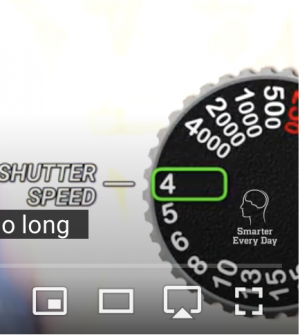xayraa33
rangefinder user and fancier
dexdog
Mentor
xayraa, thanks for posting this. I regularly watch this guy's YouTube channel, he often has interesting stuff.
ddutchison2
Established
Cool. Kind of like using an old CRT television to roughly check the speeds of a focal-plane shutter. Unfortunately I found the host gratingly annoying, especially when he got to "I'll tell you how this works, but first, here's a completely unrelated story about a road trip".
santino
FSU gear head
Impressive! Thanks for sharing.
MarkWalberg
Established
Interesting. I'd guess that this method could tell whether the two focal plane curtains are traveling at the same or different speeds. The width of the stripe would not be uniform, getting wider or narrower if the two curtains were traveling at different speeds.
I wonder how a leaf shutter looks on this, particularly at high speeds.
Rick Oleson had a page showing how to use a turntable to measure shutter speeds, but this method gives more info I think.
Rick's method is really easy though.
I wonder how a leaf shutter looks on this, particularly at high speeds.
Rick Oleson had a page showing how to use a turntable to measure shutter speeds, but this method gives more info I think.
Rick's method is really easy though.
Godfrey
somewhat colored
I think what fascinates me is the naive seeming wonder of the presenter that this can be done. The digital/electronic world of computing and high speed/high resolution sensors basically didn't start until the 1950s, and there were certainly good techniques for doing high resolution measurement long before that, with completely analog devices.
The stroboscope was invented about 1832 and it was certainly used almost immediately to analyze the timings of things like clockworks and such, which depend quite a lot on sub-millisecond-class accuracy (at least) for their functionality.
G
The stroboscope was invented about 1832 and it was certainly used almost immediately to analyze the timings of things like clockworks and such, which depend quite a lot on sub-millisecond-class accuracy (at least) for their functionality.
G
Coldkennels
Barnack-toting Brit.
I'd be interested to see that. I've only ever seen the CRT method explained, and... well... as much as I'd love to still have a CRT, I can't even find one in second-hand stores now.Rick Oleson had a page showing how to use a turntable to measure shutter speeds, but this method gives more info I think.
Rick's method is really easy though.
Still got a turntable, though.
Pál_K
Cameras. I has it.
Not related to photography, but here is another example of how the Germans developed a mechanical system which used a person’s brain and vision to decipher information not otherwise perceptible.
In the case of hearing radio signals (Morse code or voice), sometimes atmospheric conditions can make reception difficult or impossible to hear what’s being sent. Today we have digital modes which easily resolves this, but in the late 1920’s the Germans devised a way to convert radio signals to a mechanically created visual image and, cleverly, transmitted neither code nor voice, but rather images of letters. The atmospheric noise and weak signals still affected reception, but the eye and brain do a wonderful job of identifying what’s being transmitted under poor conditions.
This radio mode is called Hellschreiber. You can read about it in many places; one such site is here:
My major complaint is that all of these sites show near-perfect reception and therefore perfectly formed letters. The beauty of Hellschreiber is being able to perceive the partial shapes of letters when reception is awful.
In the case of hearing radio signals (Morse code or voice), sometimes atmospheric conditions can make reception difficult or impossible to hear what’s being sent. Today we have digital modes which easily resolves this, but in the late 1920’s the Germans devised a way to convert radio signals to a mechanically created visual image and, cleverly, transmitted neither code nor voice, but rather images of letters. The atmospheric noise and weak signals still affected reception, but the eye and brain do a wonderful job of identifying what’s being transmitted under poor conditions.
This radio mode is called Hellschreiber. You can read about it in many places; one such site is here:
My major complaint is that all of these sites show near-perfect reception and therefore perfectly formed letters. The beauty of Hellschreiber is being able to perceive the partial shapes of letters when reception is awful.
MarkWalberg
Established
Here is a description of the turntable method.
That page goes over the TV method as well.
I couldn't find it it Rick's pages.
That page goes over the TV method as well.
I couldn't find it it Rick's pages.
MarkWalberg
Established
Here is Rick Oleson's TV method for shutter testing.
He notes that this method does indeed show whether the two curtains are travelling at the same speed or not.
He notes that this method does indeed show whether the two curtains are travelling at the same speed or not.
pvdhaar
Peter
Maybe not, because this relates to a video camera?
mackigator
Well-known
Great video with slow mo of Leica shutter speed tests.
How the Germans Measured Milliseconds from SmarterEveryDay on Youtube
How the Germans Measured Milliseconds from SmarterEveryDay on Youtube
lukx
Well-known
There is already a thread about this video:
mackigator
Well-known
Thank you - I searched, but didn't find that thread before posting. Admins, feel free to delete this one.
raid
Dad Photographer
Leica rules. I am impressed.
Share:
-
This site uses cookies to help personalise content, tailor your experience and to keep you logged in if you register.
By continuing to use this site, you are consenting to our use of cookies.


